by Rajan P. Parrikar
First published on SAWF on April 30, 2001
Part 1 | Part 2
The varieties of Nat on this page fall to two lots. They are either perturbations about the parent raganga or joint projects with other ragas, i.e. hybrids. Apropos of the perturbed variants, typically a special tonal cluster is injected into the poorvanga. Or the relative weighting of a swara rejiggered, for instance, by diminishing M and advancing G instead. Or there may be an uttaranga marker – a dropped dhaivat or nishad, or some combination thereof. In the commentary that follows I will touch upon the essentials. Those readers excited about the nitty-gritty are invited to take their own measure.
Raga Shuddha Nat
The prefix “Shuddha” has many connotations. It may mean a “pure,” “unadulterated” or “original” version of a raga. Or it may denote a derived raga where the vikrit swaras of the parent have been substituted with their shuddha counterparts. In some instances the nomenclature may not have any rational explanation.
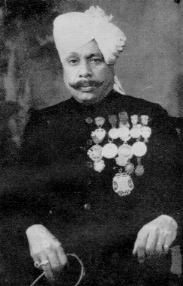
Faiyyaz Khan
Faiyyaz Khan‘s “Shuddha Nat” has all the classical markers of Nat enumerated earlier (I put that in quotes because I understand that Khansahib may not have called it by this name. But a Nat it certainly is). Additionally, a distinct phrase containing dhaivat stands out.
Recall Omkarnath Thakur‘s Chhayanat rendering of the old Nat composition, E karata ho mose. He treats that composition differently here under the Shuddha Nat brand: Chhaya’s signature P–>R is spirited away leaving behind mostly ‘pure’ Nat.
In the Atrauli-Jaipur dispensation of Shuddha Nat, the accent is shifted from M down to G. The “Shuddha” qualifier purportedly refers to Shuddha Kalyan. However, Mallikarjun Mansur‘s version does not exactly make a bold case for Shuddha Kalyan. A recurrent M GRG RSR cluster observed later in another Nat variant does, however, register. The G P S”, N DN P (G)R movement may hint at Kalyan but goes no further than that.
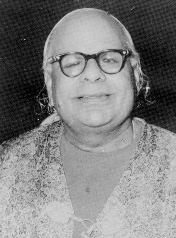
Omkarnath Thakur
Kishori Amonkar, on the other hand, affirms Shuddha Kalyan amid Nat.
Finally, the Me too! candidate by Mr. Jasraj, the musician manque. It is an unappetizing sight, Banditji laying an egg.
Raga Bihari-Nat
Notice the congruence with the Atrauli-Jaipur Shuddha Nat (M GRG RSR et al) as well as the likeness of the mukhda. K. G. Ginde: ja’o ji tuma ja’o langarwa.
Same raga, same cheez: Vilayat Hussain Khan “Pranpiya”.
Raga Sar-Nat
G P (N)D N, D P G M GRG – the distinguishing sentence of this obscure Agra specialty. Bihari Nat, Atrauli-Jaipur’s Shuddha Nat and Agra’s Sar-Nat – monuments all to the art of hairsplitting.
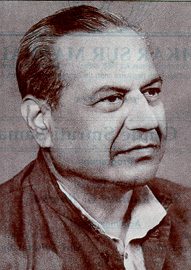
K.G. Ginde
The Agra lady Anjanibai Lolienkar of Goa.
Raga Nat-Nagari
It is anchored in Chhayanat but special swara design in the poorvanga impart a distinct personality. This is a splendid example of the dictum uccharana bheda se raga bheda.
Ramrang‘s composition addresses an event in the life of Bhartrhari. At the conclusion of his sanyasa he returns to his unfaithful wife and asks for alms, as enjoined by his guru. The penitent woman now responds:
kahe alakha jagayo jogi tum mere prana adhara
janama sudhare apno kanta
“Ramrang” humhi chhadii majadhara
Another Nat variant called Nat Narayan is rarely heard. Bhatkhande has discussed it and there’s a composition of S.N. Ratanjankar too. This is not to be confused with “Nat Narayani” peddled by Maniram and Banditji.
Next, we survey a few jod prakars of Nat.
Raga Savani-Nat
The constituent Savani is a variation of Bihag with definitive identifiers such as the P-S” and S”-P pair, the downward slide P to G bypassing M, the cluster G MP MP G and so on. The nishad, indispensible in Bihag, is rendered alpa in Savani. A sample chalan is suggested:
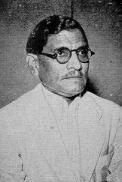
Vilayat Hussain Khan
S, S P’, P’ N, S, S P G, (R)S, S R N’, P ‘ S
S G, GMD, P, P G MPMP G (R)S
GMPS”, S” P, MP G (R)S
The motivated reader is directed to a Savani by Mallikarjun Mansur (deva deva satsanga. See Short Takes – Bihag).
The SR, RG, GM, MP stock of Nat is grafted on Savani. Additional artifacts are introduced – such as the approach to and nyasa on the mandra saptaka nishad via R S N’, and a special sanchari or two.
Jha-sahab warms up: aana paro maharaj.
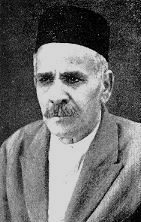
Ramkrishnabuwa Vaze
A composition of S.N. Ratanjankar, set to the uncommon Sujan Shikhara tala of 17 beats, is sketched by K.G. Ginde: suno ho gunidas niki sachi tana.
Vilayat Hussain Khan “Pranpiya” presents his own bandish.
Another eminent Agra figure, Khadim Hussain Khan.
The most engaging conception of Savani-Nat comes from Atrauli-Jaipur, a product of Alladiya Khan‘s prodigious imagination. Catch the beautiful mukhda and the special prayoga involving a leap from M to N in Mallikarjun Mansur: anahata nada.
Salve to the soul – Kishori Amonkar.
In the earlier article on Hem Kalyan was featured Altaf Hussain Khan‘s clip in Hem. His composition has an uncanny resemblance to features of Savani-Nat and one wonders if it is indeed a case of mis-labelling.
Raga Kalyani-Nat
The main theme in this uncommon hybrid is the commingling of specific Yaman sangatis within an overall Nat framework.
Raga Nat-Bihag
This perennial Agra favorite has developed a personality all its own. Bihag, typically with teevra madhyam eliminated or greatly diminished, supplies the building blocks:
S G M P; G M P N; P N S” G; S” N (D) P; P M G, R S
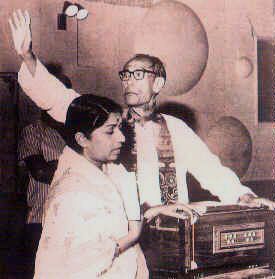
Lata Mangeshkar and S.D. Burman
But there are some no-no’s in Bihag that are permissible in Nat-Bihag. For instance, straight runs of the P D N S” or P D N D P kind are not unusual. The cluster – M n D, P – is a piquant feature; the canonical Agra compositions adopt it for their façade (mukhda). Finally, Nat weighs in with its usual baggage: SR, RG, GM, MP and S, RGMP.
Faiyyaz Hussain Khan‘s nom-tom alap.
The movie BUZDIL (1951) carried an adaptation of a famous Nat-Bihag cheez assigned to Lata Mangeshkar by composer S.D. Burman: jhan jhan jhan jhan payala baje.
The inspiration behind that tune, immortalized by “Aftab-e-Mausiqui” Faiyyaz Khan.
Mallikarjun Mansur delivers his spin on the composition.
And we hear it again, played on the sarod by Biswajit Roy Chowdhury.
Ramkrishnabuwa Vaze interrupts the Agra take-over.
The final Nat-Bihag item is standard Agra issue of Rangile’s vilambit khayal elaborated by Asad Ali Khan: kaise kaise bolata.
Raga Nat-Malhar
The potential for a fruitful union of the Nat and Malhar ragangas was recognised long ago. The earliest versions have the Malhar kernel M (M)R R P planted in Nat’s orchard.
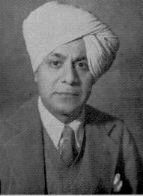
Sawai Gandharva
Ramashreya Jha “Ramrang,” with his large kitty of traditional compositions in Nat Malhar is in fine feather as he rains down with gagana garaja garaja.
K.G. Ginde takes a similar view of Nat Malhar via Ratanjankar’s composition: shubha saguna.
Kishori Amonkar introduces a second Malhar artifact – the two chromatic nishads found in Miyan Malhar. The Nat anga is beautifully expressed: barkha rtu aaye.
Sawai Gandharva: banara byahana.
Bhimsen Joshi drops subtle hints of komal gandhar into the flow.
Raga Nat-Kamod
The Atrauli-Jaipur vocalists have a virtual lock on this jod-raga. Kamod contributes the M R P and GMP G M R S molecules. And you know what to expect from Nat.
Atrauli-Jaipur founder Alladiya Khan‘s talent for designing attractive yet substantial mukhdas for his compositions has left its impress on most of the gharana repertoire. Nat-Kamod is a case in point and in Kesarbai Kerkar is found the instantiation of Khansahib’s acuity: nevara bajo re.
Ulhas Kashalkar dons the Atrauli-Jaipur hat in this private recording.
Nat Kamod is a busy melody affording no pause for think-time. In short, Mallikarjun Mansur‘s cup of tea.
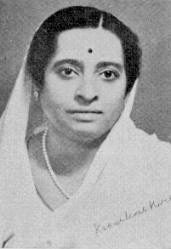
Kesarbai Kerkar
Raga Bhoop-Nat
Yet another favourite of the Atrauli-Jaipur musicians whose propensity for Nat should be evident by now. An examination of these ragas leaves one humbled by Alladiya Khan’s Promethean genius. Take stock of the gamaka cluster G M, R SS R. That melodic gesture (known in the trade as nikaas) is ‘le mot juste’ in this formulation.
Ashwini Bhide: maalaniyan laya.
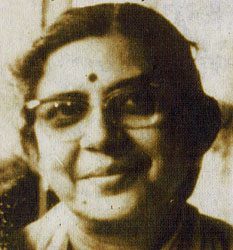
Kaushalya Manjeshwar
Kaushalya Manjeshwar first presents the standard Atrauli-Jaipur composition and then tops it off with a druta bandish composed by her guru Mogubai Kurdikar.
Raga Nat-Hamsa
A fetching blend of Hamsadhwani and Nat served by Vijay Raghav Rao.
Raga Nat-Chandra
Nat and Chandrakauns come together in this delicious cocktail. But there’s a gotcha! here since the scale is identical to that of Nat-Bhairav. Govindprasad Jaipurwale skillfully tilts the melody away from Bhairavanga and towards Chandrakauns from the get-go.
Raga Nat-Bhairav
See Bhairav – The Primordial Sound
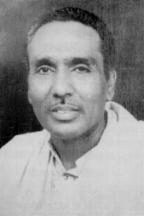
Govindprasad Jaipurwale
Raga Nat-Bilawal
This raga is discussed in On the Bilawal Trail.
Raga Nat-Kedar
Nat-Kedar is addressed in On the Variants of Kedar.
Raga Hem-Nat
See Uncommon Ragas: Hem Kalyan and Khem Kalyan.
Raga Nat-Megh
Available with cafe-au-lait at your nearest Starbucks.
Acknowledgements
My warm thanks to Romesh Aeri, Ashok Ambardar and Ajay Nerurkar. And to Anita Thakur for her patience, kindness and imagination in sustaining this project. Finally, to the many readers who wrote in to thank me, may I say, “Mention Nat” (heheheheh).
Part 1 | Part 2
